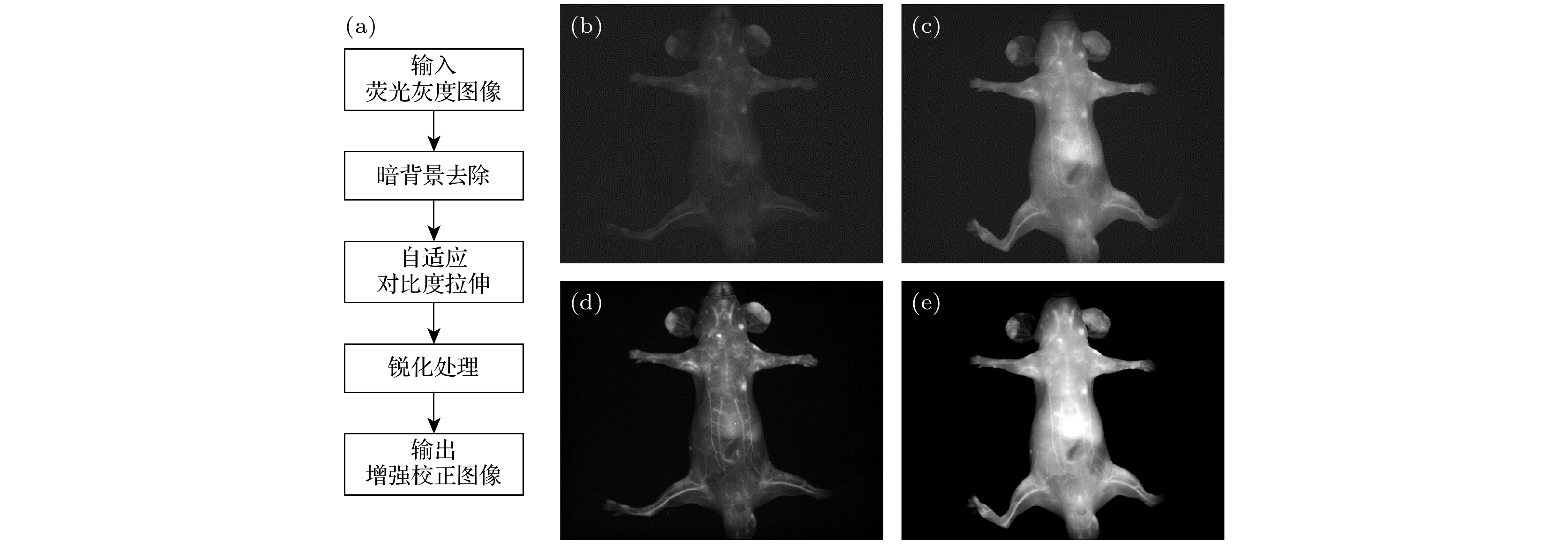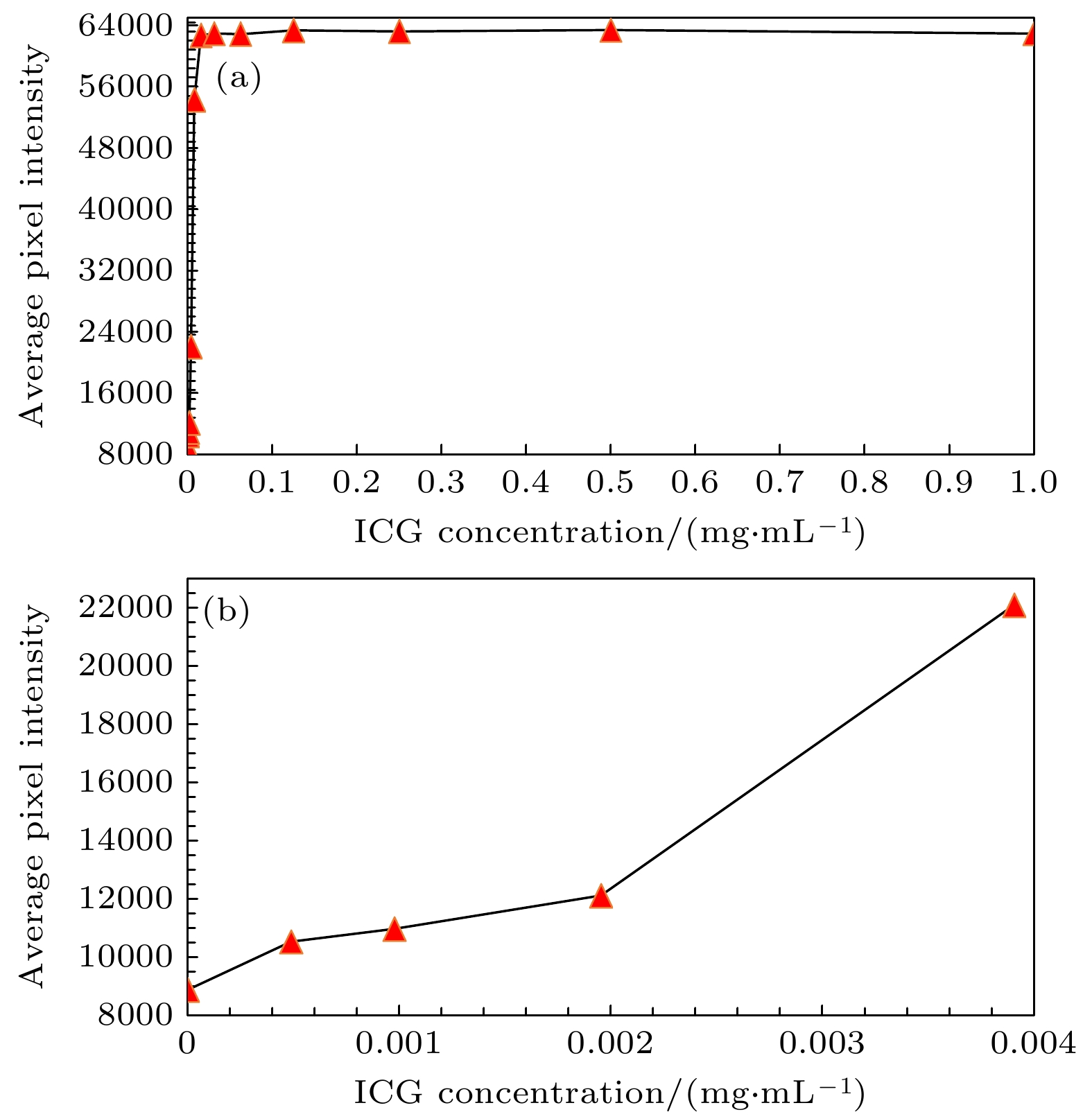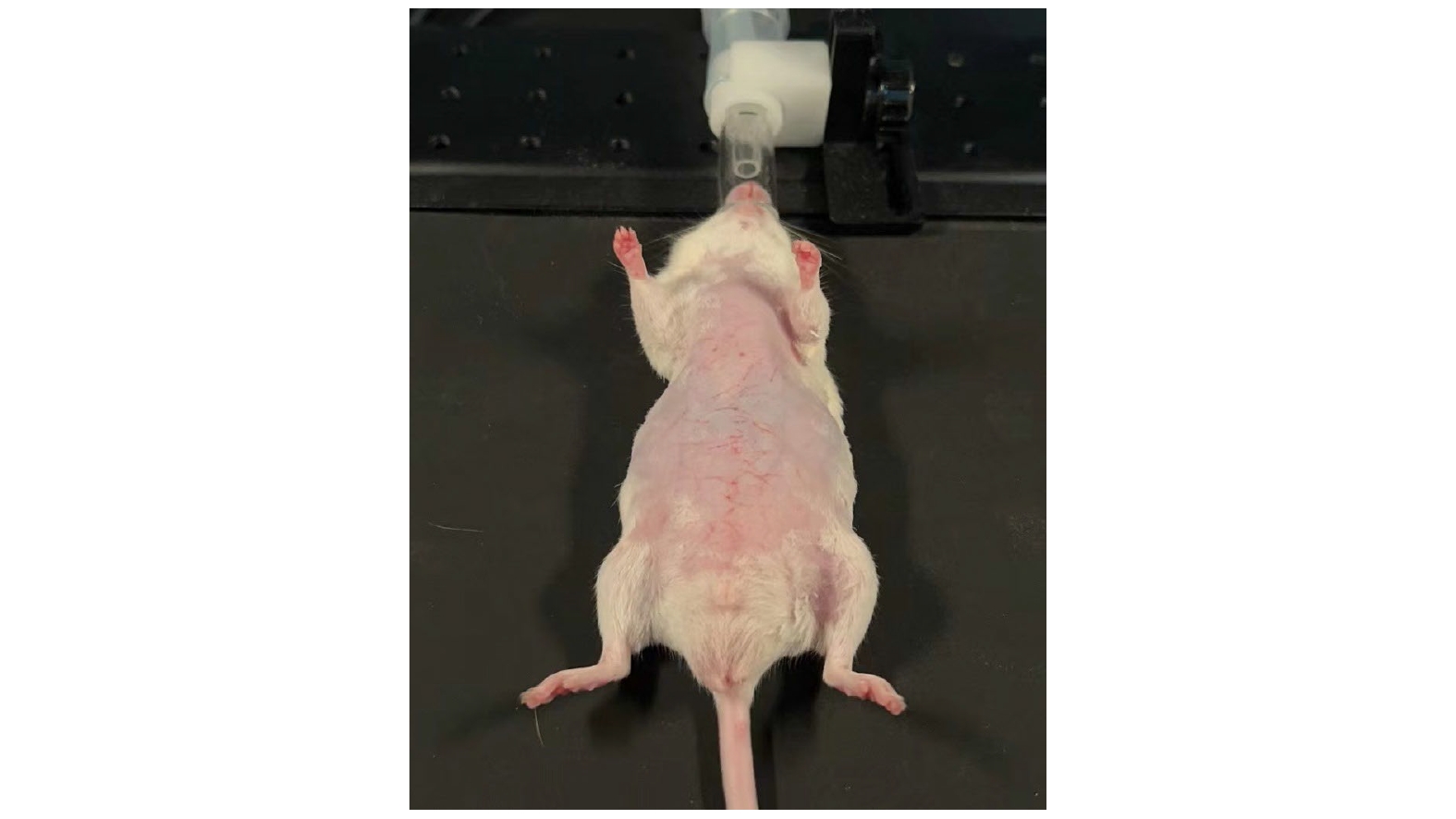-
近年来, 小动物活体荧光成像系统被广泛应用于生物医学成像研究. 但是, 现有的荧光成像系统存在穿透深度有限、图像信噪比低等缺点. 因此, 利用近红外二区(near-infrared-II, NIR-II, 900—1880 nm)荧光成像技术在生物组织中具有的低吸收、低散射和穿透深度深等优点, 研制出一套NIR-II小动物活体荧光成像系统, 提出了一种荧光图像增强校正方法, 并设计生物组织模拟实验和活体动物实验测试该系统的性能和成像效果. 实验结果表明, 该系统具有穿透深度深、信噪比高、灵敏度高等优点. 结合商用的吲哚菁绿试剂和聚集诱导发光染料, 该系统可实时监测小鼠体内的血管分布情况, 并对深层组织器官进行持续监测, 实现活体小鼠清醒状态下的动态监测研究, 有助于推动生物医学成像领域的肿瘤研究和药物开发研究等进入一个新阶段.Fluorescence imaging technology can dynamically monitor gene and cell changing in live animals in real-time, with advantages such as high sensitivity, high resolution, and non-invasion. In recent years, it has been widely used in tumor research, gene expression research, drug development research, etc. The imaging wavelength of traditional fluorescence imaging technology falls in the visible and near-infrared-I region. Due to the absorption and scattering effects of light propagation in biological tissues, and the inherent fluorescence of biological tissues, traditional fluorescence imaging techniques still have significant limitations in penetration depth and image signal-to-noise ratio. In this work, a highly integrated near-infrared-II (NIR-II, 900—1880 nm) small animal living fluorescence imaging system is developed by taking the advantages of NIR-II fluorescence imaging technology, such as low absorption, low scattering, and deep penetration depth in biological tissues. And a method of enhancing and correcting fluorescence image is proposed to optimize fluorescence images. In this work, the biological tissue simulation experiments and live animal experiments are conducted to test the performance and imaging effect of the system. The experimental results show that the system has the advantages of deep penetration depth, high signal-to-noise ratio, and high sensitivity. Combined with commercial indocyanine green reagents and aggregation-induced emission dyes, this system can monitor the distribution of blood vessels in real time and continuously monitor deep tissues and organs in mice, and conduct the dynamically monitoring research in living mice in a conscious state. This helps to promote tumor research and drug development research in the field of biomedical imaging to enter a new stage.
[1] Hong G S, Antaris A L, Dai H J 2017 Nat. Biomed. Eng. 1 0010
 Google Scholar
Google Scholar
[2] Li C Y, Wang Q B 2018 ACS Nano 12 9654
 Google Scholar
Google Scholar
[3] Cao J, Zhu B L, Zheng K F, He S G, Meng L, Song J B, Yang H H 2020 Front. Bioeng. Biotech. 7 487
 Google Scholar
Google Scholar
[4] Miao Q Q, Pu K Y 2018 Adv. Mater. 30 1801778
 Google Scholar
Google Scholar
[5] Welsher K, Liu Z, Sherlock S P, Robinson J T, Chen Z, Daranciang D, Dai H J 2009 Nat. Nanotechnol. 4 773
 Google Scholar
Google Scholar
[6] Smith A M, Mancini M C, Nie S M 2009 Nat. Nanotechnol. 4 710
 Google Scholar
Google Scholar
[7] Chang B S, Li D F, Ren Y, Qu C R, Shi X J, Liu R Q, Liu H G, Tian J, Hu Z H, Sun T L, Cheng Z 2022 Nat. Biomed. Eng. 6 629
 Google Scholar
Google Scholar
[8] Wang T, Wang S F, Liu Z Y, He Z Y, Yu P, Zhao M Y, Zhang H X, Lu L F, Wang Z X, Wang Z Y, Zhang W A, Fan Y, Sun C X, Zhao D Y, Liu W M, Bunzli J C G, Zhang F 2021 Nat. Mater. 20 1571
 Google Scholar
Google Scholar
[9] Diao S, Hong G S, Antaris A L, Blackburn J L, Cheng K, Cheng Z, Dai H J 2015 Nano Res 8 3027
 Google Scholar
Google Scholar
[10] Zhang X N, Li S S, Ma H Z, Wang H, Zhang R P, Zhang X D 2022 Theranostics 12 3345
 Google Scholar
Google Scholar
[11] Tian R, Ma H L, Zhu S J, Lau J, Ma R, Liu Y J, Lin L S, Chandra S, Wang S, Zhu X F, Deng H Z, Niu G, Zhang M X, Antaris A L, Hettie K S, Yang B, Liang Y Y, Chen X Y 2020 Adv. Mater. 32 1907365
 Google Scholar
Google Scholar
[12] Alifu N, Ma R, Zhu L J, Du Z, Chen S, Yan T, Alimu G, Zhang L X, Zhang X L 2022 J. Mater. Chem. B 10 506
 Google Scholar
Google Scholar
[13] Soref R A 1993 P. IEEE 81 1687
 Google Scholar
Google Scholar
[14] Youngblood N, Chen C, Koester S J, Li M 2015 Nat. Photonics 9 247
 Google Scholar
Google Scholar
[15] Hu F, Dai X Y, Zhou Z Q, Kong X Y, Sun S L, Zhang R J, Wang S Y, Lu M, Sun J 2019 Opt. Express 27 3161
 Google Scholar
Google Scholar
[16] Yang Y, Zhao J H, Li C, Chen Q D, Chen Z G, Sun H B 2021 Opt. Lett. 46 3300
 Google Scholar
Google Scholar
[17] Vallone M, Goano M, Bertazzi F, Ghione G, Schirmacher W, Hanna S, Figgemeier H 2016 J. Electron. Mater. 45 4524
 Google Scholar
Google Scholar
[18] Martyniuk P, Rogalski A 2013 B. Pol. Acad. Sci-Tech. 61 211
 Google Scholar
Google Scholar
[19] Li X, Gong H M, Fang J X, Shao X M, Tang H J, Huang S L, Li T, Huang Z C 2017 Infrared Phys. Techn. 80 112
 Google Scholar
Google Scholar
[20] Singh A, Pal R 2017 Appl. Phys. A 123 701
 Google Scholar
Google Scholar
[21] Feng Z, Tang T, Wu T X, Yu X M, Zhang Y H, Wang M, Zheng J Y, Ying Y Y, Chen S Y, Zhou J, Fan X X, Zhang D, Li S L, Zhang M X, Qian J 2021 Light 10 197
 Google Scholar
Google Scholar
[22] Benayas A, Hemmer E, Hong G S, et al. 2020 Near Infrared-emitting Nanoparticles for Biomedical Applications (Cham: Springer) pp11–15
[23] He Y, Wang S F, Yu P, Yan K, Ming J, Yao C Z, He Z Y, El-Toni A M, Khan A, Zhu X Y, Sun C X, Lei Z H, Zhang F 2021 Chem. Sci. 12 10474
 Google Scholar
Google Scholar
[24] Zhang Z Y, He K S, Chi C W, Hu Z H, Tian J 2022 EJNMMI 49 2531
 Google Scholar
Google Scholar
[25] Luo J D, Xie Z L, Lam J W Y, Cheng L, Chen H Y, Qiu C F, Kwok H S, Zhan X W, Liu Y Q, Zhu D B, Tang B Z 2001 Chem. Commun. 18 1740
 Google Scholar
Google Scholar
[26] Zhu W, Kang M M, Wu Q, Zhang Z J, Wu Y, Li C B, Li K, Wang L, Wang D, Tang B Z 2021 Adv. Funct. Mater. 31 2007026
 Google Scholar
Google Scholar
-
图 8 荧光成像 (a) 原始荧光图像; (b) 增强荧光图像; (c) ROI选取示意图; (d) 图(a)的ROI信背比分析; (e) 图(b)的ROI信背比分析
Fig. 8. Fluorescence imaging: (a) Original fluorescence image; (b) enhanced fluorescence image; (c) schematic diagram of ROI selection; (d) ROI analysis of signal-to-back ratio in Fig. (a); (e) ROI analysis of signal-to-back ratio in Fig. (b).
表 1 图像量化评价指标对比
Table 1. Comparison of image quantitative evaluation indicators.
评价指标 清晰度 标准差 原始低/高荧光图像 352.7 517.4 2399.9 10294.3 处理后低/高荧光图像 2520.6 723.0 8440.6 17042.3 -
[1] Hong G S, Antaris A L, Dai H J 2017 Nat. Biomed. Eng. 1 0010
 Google Scholar
Google Scholar
[2] Li C Y, Wang Q B 2018 ACS Nano 12 9654
 Google Scholar
Google Scholar
[3] Cao J, Zhu B L, Zheng K F, He S G, Meng L, Song J B, Yang H H 2020 Front. Bioeng. Biotech. 7 487
 Google Scholar
Google Scholar
[4] Miao Q Q, Pu K Y 2018 Adv. Mater. 30 1801778
 Google Scholar
Google Scholar
[5] Welsher K, Liu Z, Sherlock S P, Robinson J T, Chen Z, Daranciang D, Dai H J 2009 Nat. Nanotechnol. 4 773
 Google Scholar
Google Scholar
[6] Smith A M, Mancini M C, Nie S M 2009 Nat. Nanotechnol. 4 710
 Google Scholar
Google Scholar
[7] Chang B S, Li D F, Ren Y, Qu C R, Shi X J, Liu R Q, Liu H G, Tian J, Hu Z H, Sun T L, Cheng Z 2022 Nat. Biomed. Eng. 6 629
 Google Scholar
Google Scholar
[8] Wang T, Wang S F, Liu Z Y, He Z Y, Yu P, Zhao M Y, Zhang H X, Lu L F, Wang Z X, Wang Z Y, Zhang W A, Fan Y, Sun C X, Zhao D Y, Liu W M, Bunzli J C G, Zhang F 2021 Nat. Mater. 20 1571
 Google Scholar
Google Scholar
[9] Diao S, Hong G S, Antaris A L, Blackburn J L, Cheng K, Cheng Z, Dai H J 2015 Nano Res 8 3027
 Google Scholar
Google Scholar
[10] Zhang X N, Li S S, Ma H Z, Wang H, Zhang R P, Zhang X D 2022 Theranostics 12 3345
 Google Scholar
Google Scholar
[11] Tian R, Ma H L, Zhu S J, Lau J, Ma R, Liu Y J, Lin L S, Chandra S, Wang S, Zhu X F, Deng H Z, Niu G, Zhang M X, Antaris A L, Hettie K S, Yang B, Liang Y Y, Chen X Y 2020 Adv. Mater. 32 1907365
 Google Scholar
Google Scholar
[12] Alifu N, Ma R, Zhu L J, Du Z, Chen S, Yan T, Alimu G, Zhang L X, Zhang X L 2022 J. Mater. Chem. B 10 506
 Google Scholar
Google Scholar
[13] Soref R A 1993 P. IEEE 81 1687
 Google Scholar
Google Scholar
[14] Youngblood N, Chen C, Koester S J, Li M 2015 Nat. Photonics 9 247
 Google Scholar
Google Scholar
[15] Hu F, Dai X Y, Zhou Z Q, Kong X Y, Sun S L, Zhang R J, Wang S Y, Lu M, Sun J 2019 Opt. Express 27 3161
 Google Scholar
Google Scholar
[16] Yang Y, Zhao J H, Li C, Chen Q D, Chen Z G, Sun H B 2021 Opt. Lett. 46 3300
 Google Scholar
Google Scholar
[17] Vallone M, Goano M, Bertazzi F, Ghione G, Schirmacher W, Hanna S, Figgemeier H 2016 J. Electron. Mater. 45 4524
 Google Scholar
Google Scholar
[18] Martyniuk P, Rogalski A 2013 B. Pol. Acad. Sci-Tech. 61 211
 Google Scholar
Google Scholar
[19] Li X, Gong H M, Fang J X, Shao X M, Tang H J, Huang S L, Li T, Huang Z C 2017 Infrared Phys. Techn. 80 112
 Google Scholar
Google Scholar
[20] Singh A, Pal R 2017 Appl. Phys. A 123 701
 Google Scholar
Google Scholar
[21] Feng Z, Tang T, Wu T X, Yu X M, Zhang Y H, Wang M, Zheng J Y, Ying Y Y, Chen S Y, Zhou J, Fan X X, Zhang D, Li S L, Zhang M X, Qian J 2021 Light 10 197
 Google Scholar
Google Scholar
[22] Benayas A, Hemmer E, Hong G S, et al. 2020 Near Infrared-emitting Nanoparticles for Biomedical Applications (Cham: Springer) pp11–15
[23] He Y, Wang S F, Yu P, Yan K, Ming J, Yao C Z, He Z Y, El-Toni A M, Khan A, Zhu X Y, Sun C X, Lei Z H, Zhang F 2021 Chem. Sci. 12 10474
 Google Scholar
Google Scholar
[24] Zhang Z Y, He K S, Chi C W, Hu Z H, Tian J 2022 EJNMMI 49 2531
 Google Scholar
Google Scholar
[25] Luo J D, Xie Z L, Lam J W Y, Cheng L, Chen H Y, Qiu C F, Kwok H S, Zhan X W, Liu Y Q, Zhu D B, Tang B Z 2001 Chem. Commun. 18 1740
 Google Scholar
Google Scholar
[26] Zhu W, Kang M M, Wu Q, Zhang Z J, Wu Y, Li C B, Li K, Wang L, Wang D, Tang B Z 2021 Adv. Funct. Mater. 31 2007026
 Google Scholar
Google Scholar
计量
- 文章访问数: 7236
- PDF下载量: 136
- 被引次数: 0














 下载:
下载:









